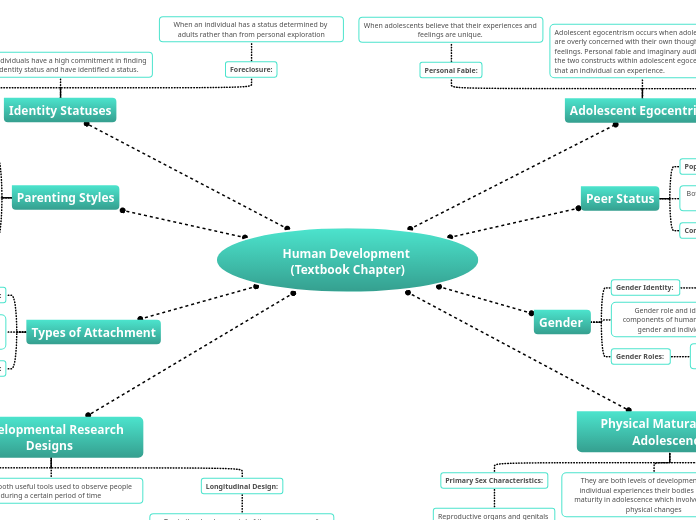Human Development (Textbook Chapter)
Adolescent Egocentrism
Personal Fable:
When adolescents believe that their experiences and feelings are unique.
Adolescent egocentrism occurs when adolescents are overly concerned with their own thoughts and feelings. Personal fable and imaginary audience are the two constructs within adolescent egocentrism that an individual can experience.
Imaginary Audience:
When adolescents believe that others are watching them constantly.
Peer Status
Popular:
When individuals are generally well liked by many of their peers.
Both individuals are liked by their peers and show a positive peer status
Controversial:
When individuals are generally both liked and disliked by their peers.
Gender
Gender Identity:
Refers to people’s sense of being male or female.
Gender role and identity both refer to the components of human development referring to gender and individuals’ perceptions of it
Gender Roles:
Refers to the behaviours that tend to accompany being a man or a woman.
Physical Maturation in Adolescence
Primary Sex Characteristics:
Reproductive organs and genitals
They are both levels of development that an individual experiences their bodies reach full maturity in adolescence which involve profound physical changes
Secondary Sex Characteristics:
Sex differentiating characteristics that don’t relate directly to reproduction (breast enlargement, deepening of voices)
Identity Statuses
Achievement:
When an individual has explored alternatives and has chosen a specific identity.
These individuals have a high commitment in finding their identity status and have identified a status.
Foreclosure:
When an individual has a status determined by adults rather than from personal exploration
Parenting Styles
Authoritarian:
Parents who are strict, provide their child with little opportunity for free play or exploration, enforce punishments and show little affection towards the child
They both involve low parental involvement and show minimal affection towards their child
Indifferent - Uninvolved:
Types of Attachment
Insecure - Avoidant:
When individuals have a dismissive attitude and avoid emotional connection with others
Both attachments are labelled as insecure. This insecurity results from parents’ styles and attitudes as they raised the individual.
Insecure - Ambivalent:
When individuals tend to be overly needy and are often anxious due their lack of self esteem
Developmental Research Designs
Cross-Sectional Design:
Compares/contrast people of different ages at a single point of time
They are both useful tools used to observe people during a certain period of time
Longitudinal Design:
Tracts the developmental of the same group of people over time
